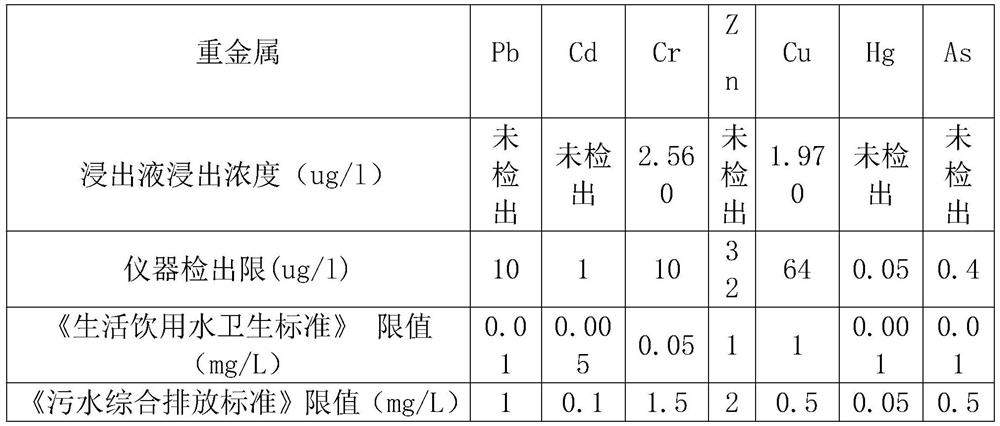Method for low-temperature pyrolysis and resource utilization of household garbage incineration fly ash
A technology of domestic waste incineration and low-temperature pyrolysis, which is applied in the field of low-temperature pyrolysis and resource utilization of domestic waste incineration fly ash, can solve the problems of limited absorption capacity, increase, slowness, etc., and achieve the effect of optimizing work performance
- Summary
- Abstract
- Description
- Claims
- Application Information
AI Technical Summary
Problems solved by technology
Method used
Image
Examples
Embodiment 1
[0037] A method for low-temperature pyrolysis and resource utilization of domestic waste incineration fly ash, comprising the following steps:
[0038] (1) After the fly ash is removed from the storage tank, it is sent to the pyrolysis furnace for low-temperature pyrolysis through a continuous feeding system with a self-sealing mechanism. The temperature of the low-temperature pyrolysis is 500°C and the time is 25 minutes;
[0039] (2) The fly ash after low-temperature pyrolysis treatment is discharged from the pyrolysis furnace through a discharge system with a self-sealing mechanism, and the total amount of dioxins in the fly ash pyrolysis products is detected to be 65ng-TEQ / kg;
[0040] (3) Send the fly ash pyrolysis product back to the pyrolysis furnace for low-temperature pyrolysis. The temperature of low-temperature pyrolysis is 500°C and the time is 25 minutes. Discharged from the pyrolysis furnace, the total amount of dioxins detected in the fly ash pyrolysis products ...
Embodiment 2
[0049] A method for low-temperature pyrolysis and resource utilization of domestic waste incineration fly ash, comprising the following steps:
[0050] (1) After the fly ash is removed from the storage tank, it is sent to the pyrolysis furnace for low-temperature pyrolysis through a continuous feeding system with a self-sealing mechanism. The temperature of the low-temperature pyrolysis is 500°C and the time is 40 minutes;
[0051] (2) The fly ash after low-temperature pyrolysis treatment is discharged from the pyrolysis furnace through the unloading system with a self-sealing mechanism, and the total amount of dioxins in the fly ash pyrolysis products is detected to be 45ng-TEQ / kg;
[0052] (3) Making qualified fly ash pyrolysis products into mine filling materials;
[0053] Weigh 15kg of qualified fly ash pyrolysis product, 50kg of slag, 20kg of slag, 15kg of industrial by-product gypsum, 5kg of red mud, and 5kg of fly ash, and grind the slag, slag, industrial by-product gyp...
Embodiment 3
[0060] A method for low-temperature pyrolysis and resource utilization of domestic waste incineration fly ash, comprising the following steps:
[0061] (1) After the fly ash is removed from the storage tank, it is sent to the pyrolysis furnace for low-temperature pyrolysis through a continuous feeding system with a self-sealing mechanism. The temperature of the low-temperature pyrolysis is 500°C and the time is 60 minutes;
[0062] (2) The fly ash after the low-temperature pyrolysis treatment is discharged from the pyrolysis furnace through the unloading system with a self-sealing mechanism, and the total amount of dioxins in the pyrolysis products of the fly ash is detected to be 42ng-TEQ / kg;
[0063] (3) Making qualified fly ash pyrolysis products into mine filling materials;
[0064] Weigh 20kg of qualified fly ash pyrolysis products, 85kg of slag, 30kg of slag, 20kg of industrial by-product gypsum, 5kg of tailings, and 5kg of ferrochrome slag, grind the slag, slag, industr...
PUM
| Property | Measurement | Unit |
|---|---|---|
| compressive strength | aaaaa | aaaaa |
Abstract
Description
Claims
Application Information
 Login to View More
Login to View More - R&D
- Intellectual Property
- Life Sciences
- Materials
- Tech Scout
- Unparalleled Data Quality
- Higher Quality Content
- 60% Fewer Hallucinations
Browse by: Latest US Patents, China's latest patents, Technical Efficacy Thesaurus, Application Domain, Technology Topic, Popular Technical Reports.
© 2025 PatSnap. All rights reserved.Legal|Privacy policy|Modern Slavery Act Transparency Statement|Sitemap|About US| Contact US: help@patsnap.com



